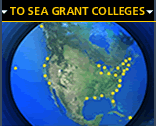


|
Aquatic invasive species (AIS) are species not native to an ecosystem, and whose introduction to that aquatic ecosystem can harm the environment, public health or welfare. AIS may constitute the largest single threat to our coastal ecosystem, our coastal economy, and human health in the coastal region. All four coasts—East, West, Gulf, and Great Lakes—and the majority of the interior of this country have been severely impacted by aquatic invasive species.
Sea Grant:
There is a Sea Grant program in every coastal state, and no program is better suited to address this problem than Sea Grant because it requires a breadth of scope that only Sea Grant can provide—research, education and outreach on all coasts; for all age groups; for government, private businesses, and private citizens; and on issues ranging from biology to economics to the physical sciences. Research alone will not solve this problem, yet we must develop a better arsenal of weapons than currently exists.
|
|
Downloads: Adobe Acrobat Reader
A publication of the National Sea Grant Office (NSGO), National Oceanic & Atmospheric Administration (NOAA) & U.S. Department of Commerce (DOC)
Accessibility and Information Quality: NOAA Section 508 | DOC Information Quality Guidelines
